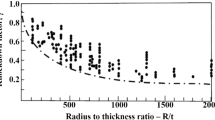Abstract—
The choice of a transport and launch container (TLC) for analyzing the stress concentration in its elements does not reduce the generality of the proposed methodology for solving problems for other thin-walled structures. The TLC is, as a rule, a cylindrical glass with a spherical bottom, at the pole of which there is a rigid mounting plate. The TLС is loaded by the internal pressure during testing, along the round areas of the spherical bottom during transportation, and by the internal pressure during the launch of the aircraft supported on a rigid plate. In this work, for all cases of loading, design schemes are proposed and the places of localization of stresses in the TPС elements are determined, the sizes of localization and the magnitude of stress concentration are determined on the basis of mathematical models of the mechanics of deformation of shells with an a priori specified error, that is, analytically.
Similar content being viewed by others
REFERENCES
V. Z. Vlasov, Selected Works, Vol. 1 (AN SSSR, Moscow, 1962) [in Russian].
Ya. M. Grigorenko and A. T. Vasilenko, Problems on the Statics of Anisotropic Nonuniform Shells (Nauka, Moscow, 1992) [in Russian].
Y. I. Vinogradov, “Solution method for linear ordinary differential equations,” Dokl. Math. 74, 480–483 (2006). https://doi.org/10.1134/S106456240604003X
Yu. I. Vinogradov and G. B. Menkov, “Modification of the multiplicative method for solving a class of boundary value problems in structural mechanics of aerospace systems limited by the Fourier method of separation of variables,” in Materials of the XXI International Conference on Computational Mechanics and Modern Applied Software Systems (CMMASS-2019) (MAI, Moscow, 2019), pp. 40–42.
A. Yu. Vinogradov and Yu. I. Vinogradov, “Cauchy-Krylov functions and algorithms for solving boundary value problems in mechanics of shells,” Dokl. Phys. 45, 620–622 (2000). https://doi.org/10.1134/1.1333870
A. N. Krylov, About Calculation of Beams Laying on an Elastic Base (Akad. Nauk SSSR, Leningrad, 1931).
F. R. Gantmacher, Theory of Matrices (Chelsea Pub. Co., New York, 1959; Nauka, Moscow, 1988).
Yu. I. Vinogradov, “Methods for investigation of stress concentrations in thin-walled structures by reduction of boundary value problems to initial value problems,” Dokl. Phys. 51, 676–679 (2006). https://doi.org/10.1134/S102833580612010X
Yu. I. Vinogradov and V. I.Petrov, “High-performance methods for investigation stress concentration in shells using mathematical models of their deformation mechanics and reduction of the boundary problem to the problem with initial conditions,” Mat. Model. 18 (9), 121–128 (2006).
Funding
This work was supported by the Russian Foundation for Basic Research, grant no. 18-08-00840/18.
Author information
Authors and Affiliations
Corresponding author
Additional information
Translated by I. K. Katuev
About this article
Cite this article
Vinogradov, Y.I. Analysis of Stress Concentration with a Controlled Error in Thin-Walled Structures (Transport and Launch Container). Mech. Solids 56, 230–241 (2021). https://doi.org/10.3103/S002565442102014X
Received:
Revised:
Accepted:
Published:
Issue Date:
DOI: https://doi.org/10.3103/S002565442102014X




